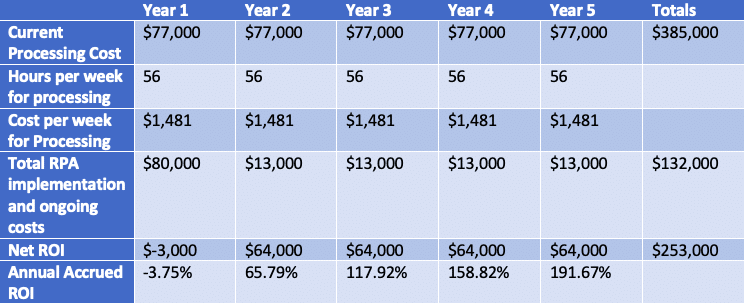How Robotic Process Automation Fuels Intelligent Document Processing
By: Troy Allen | VP Cloud Services
RPA, or Robotic Process Automation, is becoming more prevalent in the world of business process automation. In its simplest form, RPA is the practice of utilizing bots or Artificial Intelligence (AI) to analyze information and make recommendations for actions based on that analysis. RPA is not a static set of rules that a process follows. It is an evolving model that learns and adapts by examining recommendations and the actual actions taken and adjusts future actions based on what it has “learned.” In short, RPA is business process automation driven by artificial intelligence that learns as it goes to provide increasingly accurate actions and results.
As with business process automation, RPA can be utilized for many common tasks in an organization. Insurance companies leverage RPA to automate the onboarding of new clients and validate insurance claims to reduce the amount of human-based processing while increasing accuracy. Manufacturing companies utilize RPA to process Bill of Material documents and Purchase Order management. Both examples focus on automatically processing documents and associated information that normally requires a high level of human interaction and decision making.
As an essential part of RPA, Intelligent Document Processing* provides critical insights into the information being processed, helping to make the automation more accurate.
Intelligent Document Processing (IDP), a subset and critical function of RPA, interprets unstructured documents into a recognizable set of information that can be analyzed and acted upon with high levels of confidence. Using specialized Artificial Intelligence tools, IDP allows for the recognition of critical details and associations that would normally require human review to identify. For example, with forms processing and extracting key information from tables, IDP enables RPA processes to perform highly accurate analysis and actions based on that information.
RPA and Intelligent Document Processing in Action
Onboarding new employees requires a large amount of information to be collected and processed. Typical employers accept and track candidate applications, compensation details, candidate/employee profiles, onboarding documentation, performance management documentation, and various state and federal employee documents. This can result in 15 to 20 documents being processed for each employee being hired.
Imagine an organization that hires thousands of employees for seasonal work; this can result in 2,000 or more documents that have to be reviewed, processed, and acted upon in a very quick timeframe. Considering that a single document may take a human resource worker 2 minutes to review and make critical decisions about, and up to 2 hours per document to complete its process, this can result in over 4,000 hours of processing. Assuming the average resource cost for the participants involved in the processing of new employees is $25 an hour, the company could be looking at over $100,000 just to onboard these new employees! This cost is most likely higher considering that not every candidate is a fit for the role or company and more candidates must be screened, interviewed, and processed to meet hiring goals.
With RPA and IDP, automated processes could be deployed to help minimize the amount of time each processor has to interact with the various documents and the actual process. In many cases, documents can be automatically reviewed, analyzed, categorized, and routed for action based on a well-defined business process. As an example, this can reduce the overall processing of those 2,000 employees from 4,000 hours to 2,000 hours, resulting in a $50,000 reduction in onboarding and hiring costs for seasonal employees.
What are the savings with RPA and Intelligent Document Processing?
As with any process, it takes time to establish, configure, test, and update to make the process as efficient and accurate as possible. This is true with Robotic Process Automation and IDP. Many RPA tools provide a baseline of processes and intelligence based on business processes, but no two organizations operate the same way.
These baseline processes need to be modified to meet specific organizational operations. In many cases, RPA and IDP platforms provide a solid foundation to build upon, which can save significant operational costs right out of the box. RPA and IDP are designed to learn as more information is processed which means that speed and efficiency grow exponentially.
Over time, organizations that utilize RPAs can see upwards of a 40- 50% increase in efficiency and a reduction of 50% or more in processing costs. The following chart outlines the potential return on investment (ROI) of an RPA solution with IDP with 2 automated processes that traditionally take 4 full-time employees 35% of their time to perform with a salary of $55,000 annually per employee:
How to Learn More
Contact us to learn more about our RPA and IDP solution – Intelligent Document Processing (IDP) by TekStream. Through our experience and hundreds of implementations, we help companies streamline business processes and improve decision-making with a structured approach to unstructured content and data.
Using TekStream IDP, organizations can enable their users to quickly process and manage critical business documents, images, forms, video files, and unstructured data from a wide variety of sources. Fill out the form below to see how we can help you understand how Robotic Process Automation and IDP can be leveraged within your organization. You’ll improve your processing efficiency, reduce overhead, and see a return on your RPA investment quickly so you can focus on driving your business to even greater heights of success.
*Intelligent Document Processing may also be referred to as Document Understanding.



